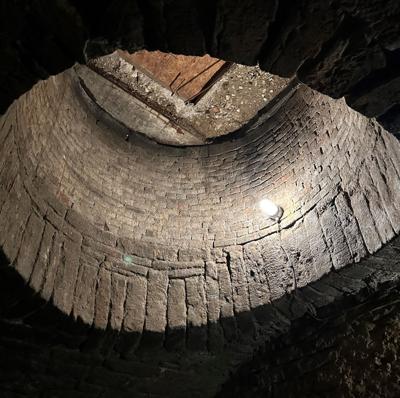CINCINNATI — Standing in the dark and damp and long-abandoned lager tunnel under a rehabbed apartment building in the , I turned my attention back west to St. Ïã¸ÛÈý¼¶Æ¬.
How similar the arc of history can be in two faraway places, once connected by rivers and now by highways.
The tunnels were once part of the Linck Brewery, which didn’t last long because apparently the beer wasn’t very good. But some tunnels, dug out by hand by German immigrants in the mid-1800s because they needed cool sites to ferment their lager, are still there.
This is the story of most major cities in America. Immigrants came — from Germany, Ireland, Italy, Spain, France, Poland and Czechoslovakia — and made a life for themselves. They brought life and commerce to their adopted homes.
People are also reading…
In Cincinnati, Pittsburgh, St. Ïã¸ÛÈý¼¶Æ¬.
I mention those three cities because they all celebrate German beer heritage and connections to rivers. They all have tunnels, too. St. Ïã¸ÛÈý¼¶Æ¬, for instance, has its under the old Lemp beer complex, though it is less accessible than the ones we toured in Cincinnati.
The stories from one city to the next are similar, and like so many elements of history, they repeat themselves.

This entrance to an underground lager cavern built in the 1800s was discovered during a remodel of an apartment building in the Over-The-Rhine neighborhood in Cincinnati.
Prohibition drove out the immigrant beer makers in many cities, and some of the neighborhoods that once thrived became boarded-up ghost towns.
After Prohibition, some of the old beer-makers found their footing — thanks, Adolphus Busch — and others didn’t. By the 20th century, new immigrants moved in, pried boards off windows and breathed life back into century-old buildings. They brought with them new tastes and smells.
This is the story of Soulard, Cherokee Street, The Grove, the Central West End, Laclede’s Landing and perhaps, one building at a time, Old North.
My wife and I were in the Queen City for a weekend because our daughter had a competition there. That’s how we have visited most the urban areas near St. Ïã¸ÛÈý¼¶Æ¬ over the past decade: following our children’s activities. We’ve been to Memphis and Ïã¸ÛÈý¼¶Æ¬ville, Chicago and Indianapolis, Kansas City and Cincinnati.
These are the cities that St. Ïã¸ÛÈý¼¶Æ¬ business leaders often point to when pushing for fancy additions to the convention center or tax credits to lure new industries. It’s common among St. Ïã¸ÛÈý¼¶Æ¬ans, because we have an inferiority gene, to visit these other cities and see something we don’t have. Why can’t St. Ïã¸ÛÈý¼¶Æ¬ have this or that, we’ll say. What are we getting wrong?
Maybe because I wasn’t born here and have adopted this wonderful city as my own, I see something else. I see our city in these other places, often in a different era or on a different scale.
Sometimes we’re first; sometimes they are. But cities reinvent themselves, often relying on the next group of immigrants as they come from Bosnia or Afghanistan, India or Mexico, Venezuela or Ukraine.
Missouri’s elected officials sometimes make that task more difficult by demonizing the next wave of immigrants, but that’s a column for another day.
After our beer cavern tour, we sat in a new brew pub built in one of those repurposed 19th century buildings. It was filling up with fans of FC Cincinnati, the Major League Soccer team that had a game in a nearby stadium. I was wearing my gear, though nobody seemed to notice.
There, too, we are two cities sharing a story that writes itself daily. New soccer-only stadiums are built in neighborhoods that need a refresher. They bring new life and economic growth into cities as they draw in people. Cincinnati got its stadium first. Ours, I say with a bit of hometown pride, is better.
In St. Ïã¸ÛÈý¼¶Æ¬, the new CityPark Stadium helped generate a boost of more than $73 million in taxable revenue in the Downtown West area last year.
That’s a lot of cash to help turn what was old into something new again, as a city re-creates itself for another generation of immigrants that hasn’t yet arrived.
There will be new taverns. Old buildings will be repurposed, and visitors from out of town will come to the newly relabeled and wonder: Why don’t we have that?
The 106-year-old building on 21st Street is just a short golf cart ride from the soccer stadium in Downtown West. Video by Steph Kukuljan, Post-Dispatch
The 106-year-old building on 21st Street is just a short golf cart ride from the soccer stadium in Downtown West. Video by Steph Kukuljan, Post-Dispatch















